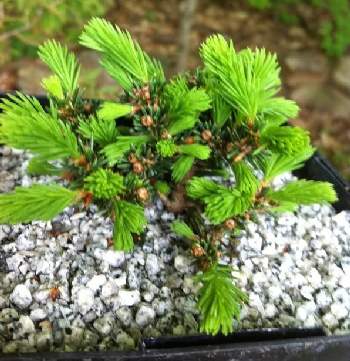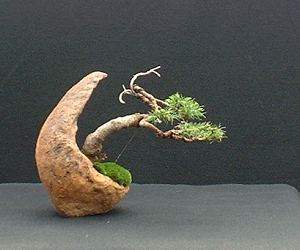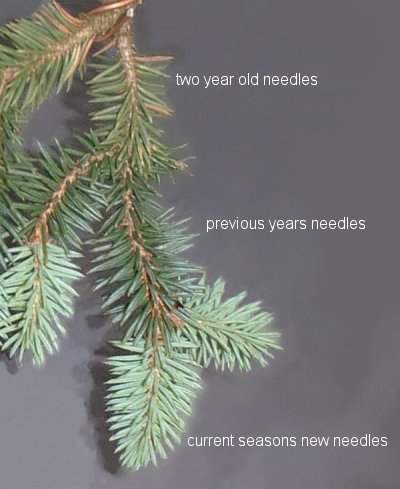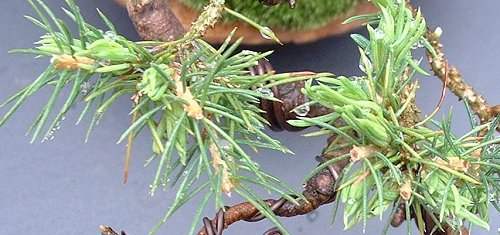Picea ( the Norway Spruce)

Spruce have a
poor reputation as bonsai. Difficult to style, difficult to encourage the
branches to set into new positions through wiring and difficult to create good
ramification with little if any prospect of backbudding.
Unfortunately, the ubiquitous Picea albertiana 'conica' has not helped matters;
very often picked up by beginners looking for nursery trees to style into
bonsai, the Alberta spruce has been known to cause great annoyance and
frustration!
However, there are some excellent examples of Spruce bonsai in Europe and
Japan; the genus as a whole has some excellent qualities and very often, it is
just a question of learning how to work with Spruce and its foibles so that the
best can be made of this tree.
This article is primarily based on my experience of Picea albertiana and Picea pungens though these techniques can also be applied with degrees of success on all vigorous Picea/Spruce bonsai.
Spruce vigour
The techniques described in this article
assume that your Spruce is vigorous and that care is taken when applying these
techniques to weak lower and inner branching.
The easiest way to judge the vigour of a Spruce and its individual branches is
to look at the number of new buds that have formed, very often at the tips of
the foliage, in late Summer.
Branches with
no buds are very weak and are likely to fail/dieback in the following Spring.
These are best left alone.
Branches with one bud are weak and will tolerate minor wiring and needle
plucking.
Branches with two or more buds are strong to very vigorous and all of the
techniques described can be applied.
Timing
Spruce are
sensitive to timing. In particular, styling and wiring must not be carried out
while the tree is in active growth as branches are very likely to fail and
dieback.
In the UK, extensive styling is best carried out from late Summer (August)
through to the first frosts around November.
Wiring
Spruce have
incredibly supple branches. With the use of thick enough wire and guy wires,
branches of over 1" can easily be bent without danger of snapping or
cracking. Thinner mature branches can be bent and contorted in a variety of
directions to bring the foliage closer to the trunk.
This suppleness is also problematic; wired mature branches can take years to
set into their new position, often requiring repeated rewiring. However, I
found that on a number of occasions, branches that have had twists and turns
put into them have set into position within a year.
When branches of any tree species are wired into a new position, the cambium is
broken (however minutely) and the repair of the damaged parts of the cambium
layer, by the tree, sets the branch into its new position. With Spruce, it
would seem that more manipulation is needed to damage the cambium in order that
the tree will be prompted to repair the damage and set the branch.
However, care must be taken as major manipulation of a Spruce branch in the
late Spring and Summer will cause it to dieback very quickly. This is why
Spruce should be styled from August onwards. After this time I have found that
Spruce are very tolerate of all wiring and styling.
Styling
Featuring short
needles and very often an overall dense foliage mass the Alberta Spruce seems
eminently suitable for bonsai but once the bar branches have been removed, the
enthusiast often finds that he is left with a small number of thin, ill-spaced
branches that only have foliage growing on the tips.
When considering which branches to keep and those to remove, always value and
retain those that have foliage closest to the trunk. Though backbudding can be
promoted on Spruce, this will always be limited. Do not rely on any backbudding
on the trunk or old branches unless the tree has been very heavily pruned back.

Unless a Spruce has been specifically trained in the ground for bonsai and the branches are appropriate (short with foliage near the trunk), the most suitable design will be one that uses the first 2 or 3 branches with the uppermost (remaining) branch used for the new trunkline and imitates a wild tree or yamadori.
If one studies pictures of good quality Spruce bonsai on the internet or in
books, as with Juniper, many of the designs use only a very small number of
primary branches (that is branches that grow directly from the trunk) but have
had many secondary and tertiary branches developed to greatly increase
ramification and foliage density.
Unless you have suitable raw material with the appropriate sized trunk and
short branching, informal or formal upright Spruce bonsai are very difficult to
style realistically or to any real quality.
Pruning Spruce
Left to their
own natural growing pattern, Spruce will produce one flush of growth each year.
New shoots extend from buds set in the previous year; these buds are nearly
always at the tips of the branches. Backbudding without some kind of pruning
regime is very rare.
Without some forward planning and planning, all the needles of the tree will be
on the tips of the branches leaving otherwise bare branches.
The Annual Cycle of Pruning
(The exact timing will vary slightly according to your climate and location)
August-October: Needle plucking, wiring and pruning back of this years shoots to a bud if necessary. To tidy up a foliage pad, new shoots formed in the current year can be pruned back to a bud further back along the shoot. Pruning back leaving no bud for next year will sometimes result in a new bud forming and sometimes will result in dieback of the whole shoot.
As you would a pine, needles can be plucked from the previous years growth,
this will occasionally prompt backbudding and makes wiring considerably easier
and neater. Do not needle pluck weak shoots. Trees that have been repotted
earlier in the season should be observed carefully for vigour.
Needles can either be plucked with fingers or cut with scissors at the base of
the green part of the needle leaving the brown sheath that attached the needle
to the branch itself.
|
|
Small branch of a Picea pungens (Colorado Spruce) From May/June onwards the current seasons growth is easy to identify with all Picea species as it has a lighter more vibrant colour and soft wood. This shoot has only been pruned back in August each year to stop the branch elongating too far. As the May cutting back of new growth has been missed, there has only been one flush of growth each season and the overall foliage density of the shoot is poor. |
May: Cutting back the first flush of growth.
New growth extends from the buds set last year. Allow to extend 1"-2"
and then cut the new green shoots back with scissors. On strong apical shoots,
cut back by a 1/3, on weaker shoots or those on the lower branches cut back by
a ½ or less.
On very weak branches or where a branch is required to extend, do not prune
back.
Do not allow the new shoots to extend too far before using this technique or backbudding will be limited.
|
|
This image was taken 2 weeks after the new shoots were pruned back (Picea glauca). It is possible to see both the pruned tips of the new growth and the resulting fresh buds starting to extend. |
May-June/ 2 to
3 weeks later: the second flush of growth follows
In the weeks immediately following new growth pruning, a second flush of buds
will develop and start to grow. New buds will develop at the point that you
pruned the first flush of growth back, at the base of the first flush of growth
and further back on older wood, very often where needles were plucked in the
previous August to October.
The second flush of growth will emerge from many points but each new shoot will be much shorter creating much more dense growth. Allow these shoots to extend only pruning back any unwanted individual shoots that grow much stronger than the others.
The tree should then be left until at least August to reinvigorate and develop new buds ready for the following year. The year long cycle is then complete ready for needle plucking to be carried out again.
If you do major styling, let the tree recover for 12 months or more before repotting.
Repotting
Repotting is best done in spring - just before the buds break. After repotting protect the tree against frost and cold winds. Repotting and pruning at the same time is bad for conifers - don't do it.
Collecting
Collecting spruce is a challenge. When you collect a tree, you will certainly be reducing the roots quite radically and itís probable that you will also have to reduce the foliage.
Generally with spruce and other evergreen conifers, it is best you try to avoid radically reducing both terminal branch buds and roots at the same time. For this reason, when you repot a spruce, it is best to give the tree at least one or more growing season of unrestricted growth to allow new roots to redevelop.
The ideal method would be to collect the tree over a number of years. Firstly cut the roots around the largest soil ball you can carry. Leave it to recover for 12 months, then prune back the foliage. Leave it to recover for another 12 months, then collect the tree. But often we do not have this amount of time. Most times you just have to take a chance and accept that not all collected trees will survive. The more traumatized a tree is when collected the better your after care will need to be. 3 years to recover from collecting is not uncommon.
The best time to collect Spruce is just before bud break, but you do need to protect them from frost and high winds until they have had at least one growing season to develop new roots.

